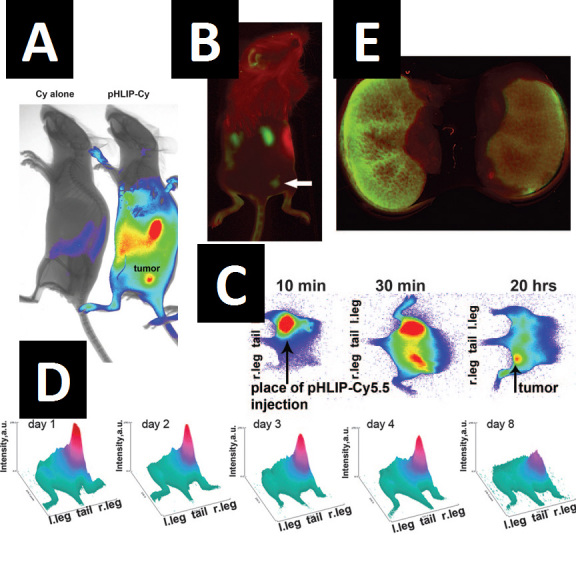Figure 2.

Intravenously and intraperitoneally injected pHLIP-infrared dye conjugates localize preferentially to tumors. A) Overlay of NIR fluorescence and X-ray images obtained the day after injection of 500µg/kg pHLIP-Cy5.5 conjugate (right) or an equivalent amount of free Cy5.5 (left) into mice bearing tumors in the right flank. Peptide injection was performed on the sixth day after an initial cancer-cell implantation of 5x104 cells subcutaneously. Localization of the fluorophore is seen in the tumor, kidneys, and spleen. B) pHLIP-Alexa750 fluorescence (green) in a mouse bearing a tumor in the right flank (6 days after 106 cell implant) imaged the day after peptide injection. Reflectance is denoted in red. Localization of the fluorophore is seen in the tumor (arrow), kidneys, and spleen. C) pHLIP-Cy5.5 given as a single injection (200µg/kg) into the left side of mice initially diffuses, accumulating in the right flank tumor by 20 hours. Blue represents background and red represents the highest fluorescence. D) 3D representations of pHLIP-Cy5.5 fluorescence from a tumor-bearing mouse at different days after injection of 500µg/kg peptide. Peptide injection was done on the seventh day after subcutaneous tumor implantation. The height (z axis) and intensity of red indicates the strength of NIR signal, showing that pHLIP retention lasts for several days. E) The NIR fluorescence of kidneys 2 days after injection of 500µg/kg pHLIP-Alexa750 into mice fed water (left) or 80 mM NaHCO3 at pH 8.2 (right). The alkaline treatment resulted in an approximate 50 percent reduction of pHLIP kidney retention without affecting tumor localization. Figures reprinted from [15]: Andreev OA, et al. Mechanism and uses of a membrane peptide that targets tumors and other acidic tissues in vivo. Proc Natl Acad Sci USA. 2007;104(19):7893-8, reused according to permissions guidelines.
